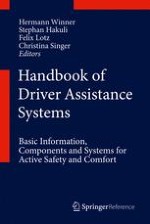2016 | OriginalPaper | Chapter
12. User-Oriented Evaluation of Driver Assistance Systems
Authors : Jörg Breuer, Christoph von Hugo, Stephan Mücke, Simon Tattersall
Published in: Handbook of Driver Assistance Systems
Publisher: Springer International Publishing
Activate our intelligent search to find suitable subject content or patents.
Select sections of text to find matching patents with Artificial Intelligence. powered by
Select sections of text to find additional relevant content using AI-assisted search. powered by
